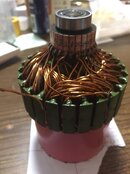Gone for diving
Contributor
This is incorrect
Max charge for li-ion is 4.2V per cell. a 4S pack is 16.8V and despite the ~15amp load is not likely to drop below 15V when fully charged - which is way higher than an single SLA battery. Which is exactly what Jona was explaining above.
Yes you would be correct for li-ion...
Max charge is 4.2v but nominal voltage is 3.6v max discharge is about 3.2v I believe.... normally use nominal voltage to do math for calculations...
Lithium iron max charge on a 4 pack is 14.4V, (3.6v per cell)
but that is not nominal voltage.... 3.2v per cell X 4 cells is 12.8V.... on use it drops to 3.2 v relatively fast and holds the voltage... anything below 3v, capacity drops fast...
This was for lifepo4 batteries
which is different.... what is nice is these batteries can be used to replace a 12v lead acid in a vehicle and falls nicely in the charging range of a vehicle etc...
My battery is a lifepo4 battery so it's not overvoltage. It is 14.4v with 3.6v 4 cells.
Was trying to point out in this post... that a lifepo4 doesn't stay very long at 14.4v
Because its nominal voltage is 3.2v and will spend most of its burn time around that voltage...
Li-ion and lifepo4 battery
are different types of batteries






